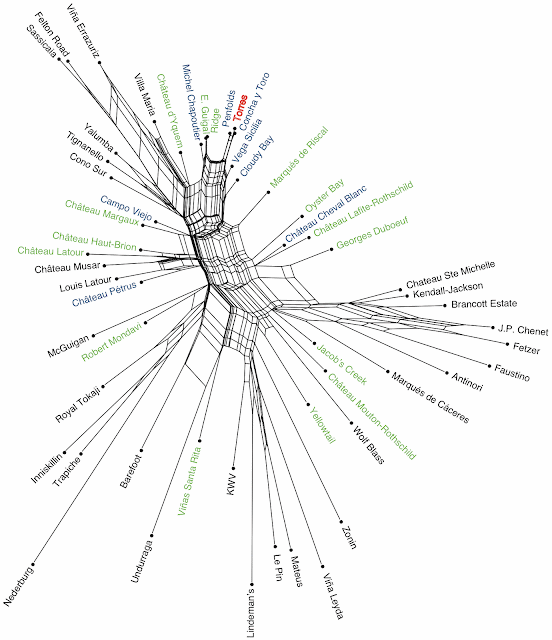Each year, the April edition of Drinks International magazine contains a supplement with a survey called The World’s Most Admired Wine Brands. A group of people are asked to vote for the wine brands they "most admire" based on the criteria that each brand should:
- be of consistent and / or improving quality
- reflect its region or country
- be well marketed and packaged
- respond to the needs and tastes of the target audience
- have broad appeal among wine consumers.
The people polled each year are drawn from "a broad spectrum of the global wine community", which apparently includes: masters of wine, sommeliers, commercial wine buyers, wine importers and retailers, wine journalists, wine consultants and analysts, wine educators, and other wine professionals. There were only 60 people involved back in 2012, but there are now more than 200.
The people could originally vote for up to six wine brands, but apparently they are now asked for only three choices. Furthermore, they are provided with a list of previous winners, including "a list of more than 80 well-known brands and producers, but as usual we also encourage the option of free choices".
I have compiled the poll results for the years 2011-2020 inclusive. Each of the published lists contains only the results for the top 50 ranked wine brands in that year — all we know about the other brands is that were ranked lower than 50th place in that year. We also do not know how many people actually voted for each of the brands that did make it into the top 50.
Across the 10 years, 116 different brands have appeared at least once in the lists. However, only 9 of these brands appeared in all 10 lists, with a further 15 brands appearing in 9 of the 10 lists. There have been 36 brands (31%) that appeared only once each. There is thus a great deal of variability in "admiration" from year to year.
As usual in this blog, we can get a picture of this variability by using a phylogenetic network, as a form of exploratory data analysis. For the first analysis, I calculated the similarity of the 10 years using the Bray-Curtis distance, based on all 116 wine brands. A Neighbor-net analysis was then used to display the between-year similarities, as shown in the graph above. Years that are closely connected in the network are similar to each other based on the ranking of the wine brands, and those that are further apart are progressively more different from each other.
This graph shows a basic gradient from 2011, at the top-left, anti-clockwise around to 2020, at the top-right. So, the rankings changed progressively through time, which is not unexpected. However, the first three years, clustered at the left, are quite different from the seven later years, at the right. Indeed, one brand (Black Tower) appeared only in the first three years, while five others appeared twice there only.
Also, this year, 2020, is notably different from previous years (as indicated by the long terminal network edge). Indeed, quite a few long-standing wine brands disappeared from the list this year, including six that had appeared in every previous list. These were replaced by 15 new brands, which had never appeared before, including the brand ranked first (Catena, from Argentina).
We can look at the brands (instead of the years) by doing the same form of network analysis. To simplify things, I included only those 55 wine brands that appeared in at least 4 of the 10 lists, as shown in the next graph. Each brand is represented by a dot in the network. Brands that are closely connected in the network are similar to each other based on their rankings across the 10 polls, and those that are further apart are progressively more different from each other.
Basically, the network progresses from the most highly admired brands at the top down to the less-admired wine brands at the bottom. High admiration can be achieved either by being ranked in the lists in most years, or by achieving a high ranking in at least a few years.
Clearly, the most highly admired brand is Torres (from Spain), which is marked in red in the network. It was ranked in the top 3 in every year; and, indeed, it was first or second in each of the first nine years, dropping to third this year. Penfolds (from Australia) was ranked in the top 5 every year, while Concha y Toro (from Chile; known for their Casillero del Diablo wines) was always in the top 6. Nothing else comes even close to these three brands (eg. Vega Sicilia, also from Spain, varied from 2nd to 14th).
Those brands that appeared in all 10 lists are shown in blue in the network, while those in green appeared in 9 of the 10 years. Note that some of the latter are at the bottom of the network, indicating that they rarely ranked highly, when they did appear in the lists.
Those countries that produce the most wine dominate the lists, of course, although the two biggest producers, Italy followed by Spain, do not do the best in terms of admiration. This is shown in the table of how many of the 116 wine brands come from each country.
| France Australia Spain USA Italy New Zealand Chile South Africa Portugal Germany Argentina Canada China Hungary Lebanon | 21 16 15 13 9 9 8 8 7 3 3 1 1 1 1 |




No comments:
Post a Comment